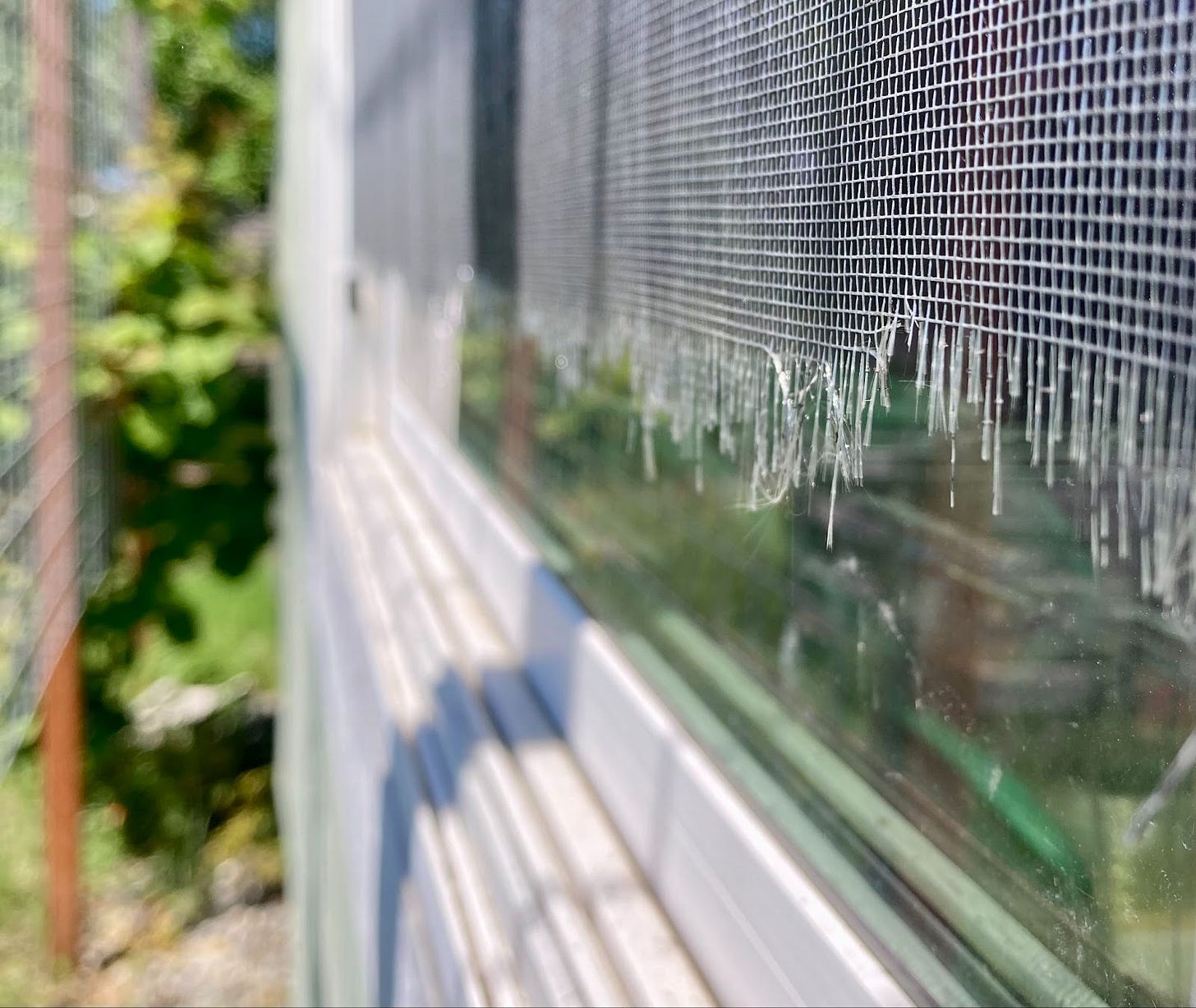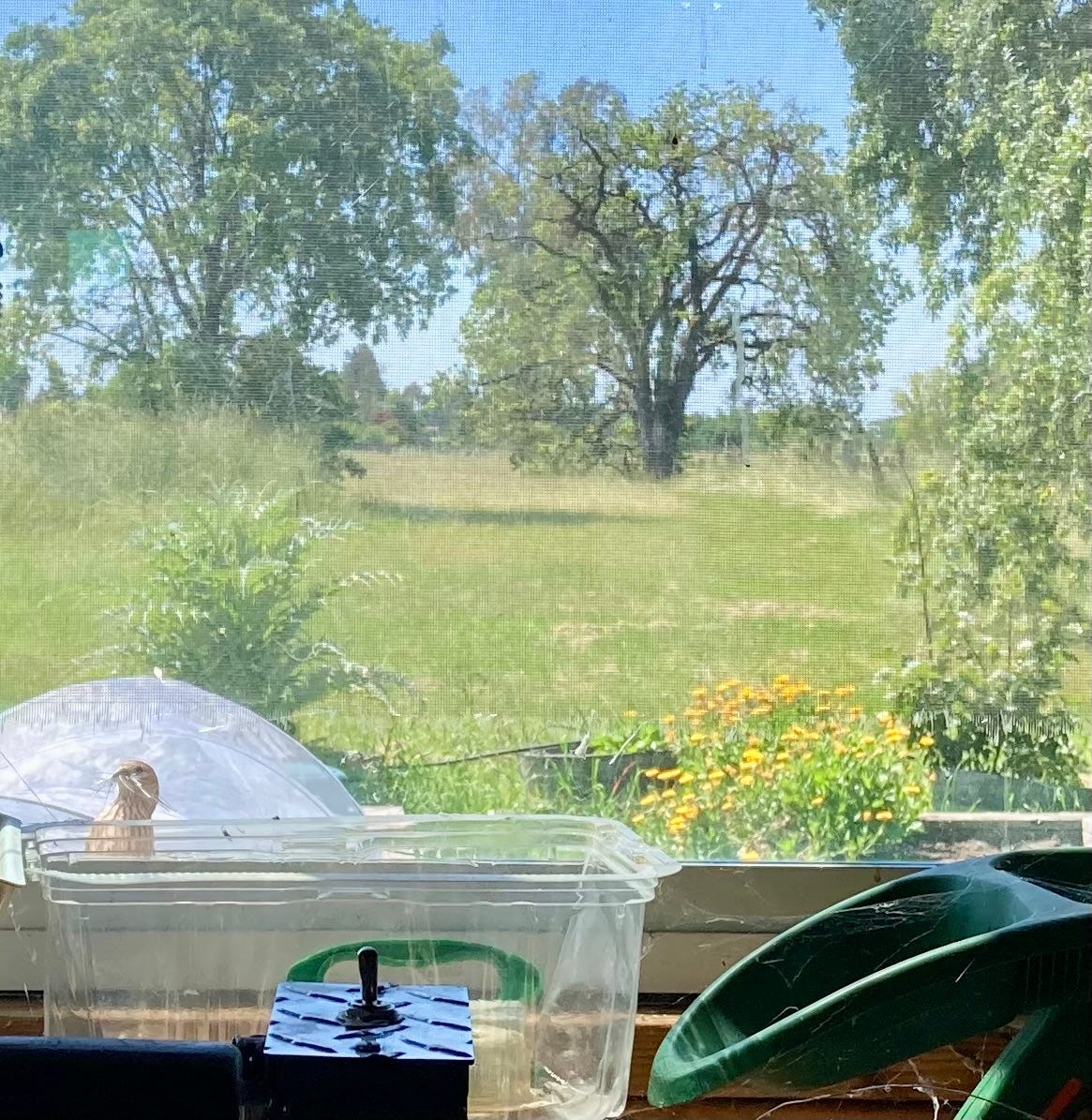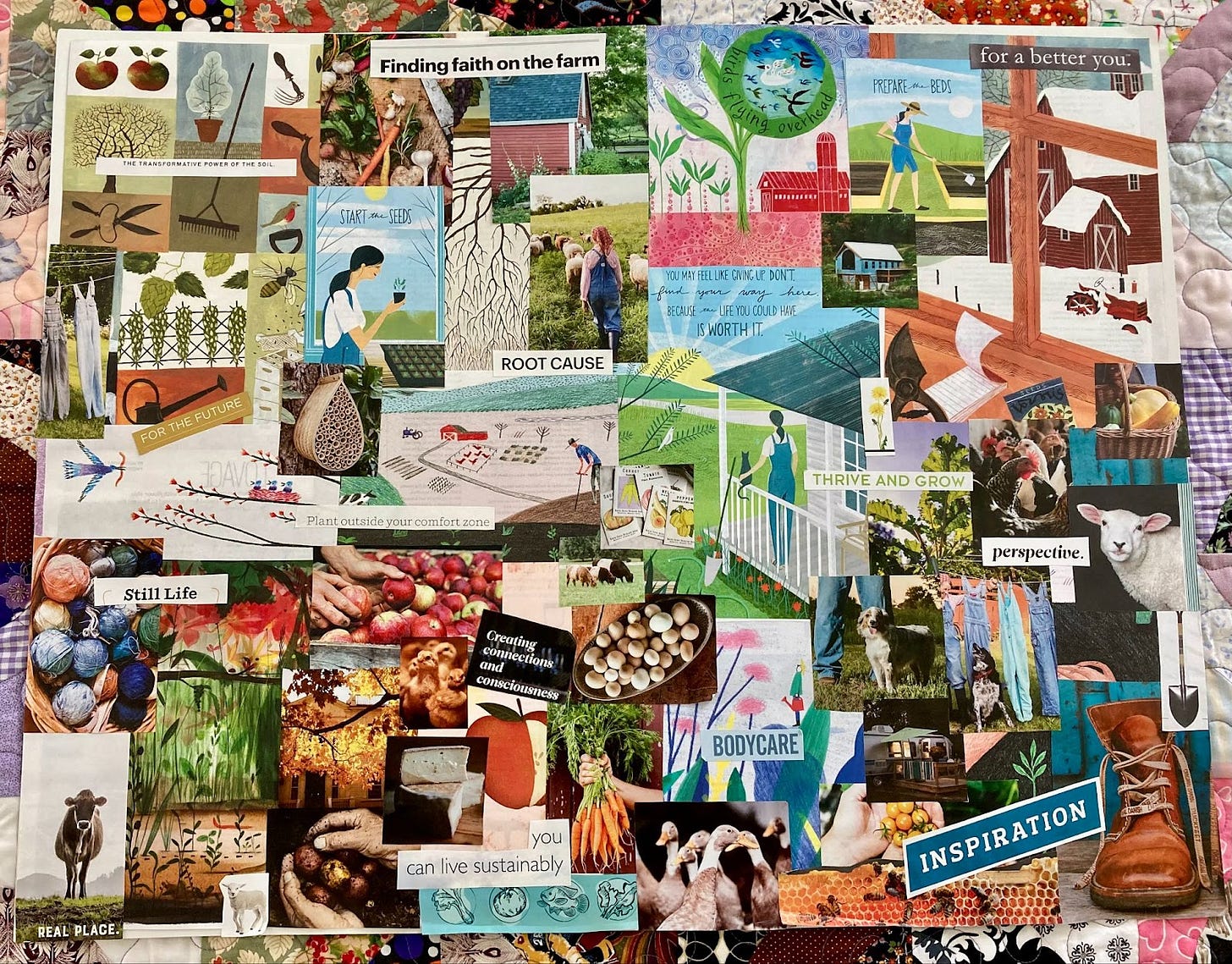The Generative Work of Spring: Lean into the Impractical
Even when facing great obstacles, make room for creative play.
Welcome to Natalie's Field Notes.
Take off your work boots, set down your tools, and spend a few minutes observing the farm with me.
🪺 My Limping Turkey, Act II
From my deck I spotted the limping turkey. She hung close to the ground to prevent me seeing her, but I saw the asymmetrical movement of her body.
She had been missing for one month. I assumed with her disfigured foot, she had become a meal for a coyote. I was glad to see her.
She hid behind the cluster of redwoods, while I did my morning Qigong.
I next went to organize my garage. While moving a box of citrus fertilizer to the shelves, I noticed a brown-flecked house finch perched outside the window over my workbench. I looked up at her mate, with his red-plumage head, keeping watch on the top of the trellis as she worked.
She was harvesting my frayed window screen. The once small hole was no longer small. The finch plucked at fragments, creating a neatly trimmed rectangle, like someone pulling out rows of knitting. She hopped along the window ledge collecting supplies, which poked out on each side of her beak like a silver-bristle mustache.
In a second, having reached the end of a row, she and her companion were away, off to do some weaving.
Around noon, that same beautiful Sunday, I looked out my kitchen window and saw my turkey limping around the two rose bushes. She often tilted her head with one eye towards the sky as my chicken Carlotta used to do. She was watching for hawks and the danger that arrived with them.
And then, I saw them. Little brown fluffs. One, two, three, four, five, yes, six of them, barely taller than the cut grass. She, like the finches, was about the work of spring.
Some of her miniatures scurried to be under her. Periodically, the stragglers stumbled to catch up, condensing the group rapidly, after which it expanded again. Everyone inspected the ground with interest, just as their mother, who towered lopsidedly above them, modeled.
My turkey hen jutted her head out in a quick movement, grabbing what I expected was not a blade of grass, but a delicious bug. A chick rushed to see what had just happened.
As her children explored, my turkey mom noticed a fluffy mound of soil pushed up by a gopher. She plopped down as the chicks wobbled around her, and indulged in a dust bath, shaking the cool dirt into the nooks around her feathers.
They moved on to a spot in the tall grass, in the shade of the young willow tree. The nearby rotten stump of that willow’s mother made a hollow. It had been a favorite of my chickens. This family made it their protective home for the afternoon.
I wondered about her. Can she make it? Her foot is clubbed. She can fly away from danger, but not run with her six chicks.
I walked next door to tell my aunt of the joy and the angst of it. After discussion, we agreed. It didn’t matter if she or her chicks survived that night or the following day. She was doing it. She was there right then, going about her meaningful work.
It was happening in the creative now.
📓 Field Notes – Creative Play as Your Hopeful Act
Recently, in my creative now, I led a small group retreat at my farm and spoke to the San Jose Q Place Bible Study. At both events I performed The Service Station, a story from my recovery.
In the story I recount how I assigned myself three habits to break from a fear cycle. My homework was to choose the risky, the impractical, and the whimsical options.
I loved witnessing gasps of delight as the audience heard the story unfold. I won’t spoil the magical ending here. (If you have a group interested in hearing it, please contact me. I look forward to sharing it again!)
One of the themes of the story is the importance of engaging in life with a playful, creative spirit — not in spite of difficulty and pain, but to heal from it.
Last month, I wrote about limiting beliefs. One that held me back was that I could only relax and play when everything (and everyone) was taken care of.
Learning about neuroscience taught me I couldn’t afford to not make room for play. My overwhelmed nervous system needed non-judging, free-flowing moments to signal hope and safety.
I remember lying on my floor, piecing together a collage over many days as part of an assignment from the Artist’s Way.
I had such limited energy, it seemed absurd. I still needed help getting groceries, cooking, cleaning, and yard work. A voice told me, you need to be able to do those things before creating “frivolous” art. I gently reminded that voice that we were doing exactly what was needed.
In a time of great transition and social disruption, it is easy to fix our complete attention on reported threats. It can feel “now” is not the right time for creation.
However, as Amie McNee argues in a recent Tedx Talk (Warning: some spicy language) creating art in these times isn’t just okay, it is a necessity.
I watched my turkey and her babies for two more days before they moved on. On the second day the mamma flew to the tall grass on the other side of the fence, but the chicks, no more than four fingers high, kept popping through the wire holes to forage on my side.
She paced anxiously. I herded them through the fence, but still they returned. I wished the mom would fly over, to relieve me of nagging thoughts.
I read in my lounge chair, attempting to ignore the situation. I was only partially successful.
Then, I heard a loud ruffle of feathers. She had launched herself up, flying over one hundred feet towards me, chasing a hawk away.
She landed with a flap and fluster in the redwood tree, some thirty feet above my head. She immediately glided back to her chicks, landing now on my side of the fence.
My turkey had only one good foot to grasp a tree branch, but she did what was needed.
I marveled. I had doubted her abilities. Her life seemed unnecessarily hard. Had that turkey sought my counsel a month before, I would have probably suggested, due to her limited ability, that she focus on keeping herself safe, rather than creating new beings to nurture.
Yet, she was about her mission, just like those industrious house finches happily trimming my window screen. They were going about their business of creating and passing on life.
It is a generative time of year. My orchard is pushing its energy into plumping out fruit. Volunteer sunflowers are forming towers in my garden, and the mixed flower seeds I planted already have blooms.
Join in this creative project of life, most especially when it feels impractical.
🌱 Planting Instructions
Schedule 30 minutes each week for whimsical play. Make it a priority action item. You have the time. Check social media less. Limit your news intake.
Bring out the finger paints. Press flowers in wax paper. Put on music and doodle. Take a walk and fill your pockets with rocks like you were five years old.
🌞 Farmer’s Almanac
I set the first draft of my book aside to compost in April, and had great conversations with six friends who generously shared editing advice.
In May, I went back to the text. I undulated between excitement and thinking I had written a terrible book. A normal reaction, I understand. I completed an editing pass and celebrated my first goal: I wrote an adequate book!
I am grateful for friends who agreed to be beta readers in June. They’ll help me to my next goal: writing an engaging and well-crafted book.
Wishing you Peace and Goodness,
Natalie 🐦⬛





You have such a Gentility in your message and writing. I look forward to reading more. Bravo
Yeah!